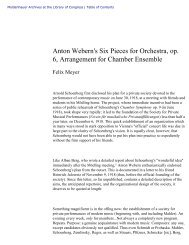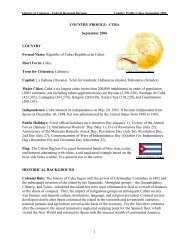1 - American Memory
1 - American Memory
1 - American Memory
You also want an ePaper? Increase the reach of your titles
YUMPU automatically turns print PDFs into web optimized ePapers that Google loves.
181<br />
It would free this isolated island community from the continuing threat of a<br />
devastating cutting of its lifeline.<br />
It would have the further advantage of giving this proposal a laboratory test<br />
to see how it works and what administrative problems would be involved if<br />
legisaltion providing for partial operation in struck transportation industries<br />
were enacted for the country as a whole. After all, the main objection to lim-<br />
ited partial operation of an industry during an emergency strike Is that the<br />
administration would be too difficult. This would provide the country with a<br />
laboratory or test tube experience with respect to the workability of such a<br />
procedure.<br />
One of the administrative problems of partial operations would be proper<br />
rate setting since unit costs tend to skyrocket when an industry is operating at<br />
only a small fraction of capacity.<br />
Since the key to the partial operations proposal is that operations must be<br />
confined to a small segment of the industry, the primary question is: What<br />
fraction of the airline industry, the longshore industry, or the maritime in-<br />
dustry would be involved if Hawaii were in effect exempted from the strike<br />
through this partial operation procedure? As we shall see, the answer is such<br />
a tiny fraction that it would in no way alter the course of the negotiations.<br />
Airlines.—The ten U.S. trunk carriers operate 1,7.T6 aircraft. Of the eight trunk<br />
carriers serving Hawaii, current schedules call for 41 round trips per day from<br />
the Mainland U.S. to Hawaii. One aircraft can make at least one round trip each<br />
day. These 41 aircraft would constitute less than 2% percent of the fleet.<br />
West Coast Longshore.—-In the course of normal operation in the West Coast<br />
ports, only 3 perent of the total longshore hours worked are devoted to handling<br />
commodities bound to or from Hawaii. Or. out of the current normal work force<br />
of nearly 11,000, only about 300 men would be involved.<br />
West Coast Maritime.—Of the man-days worked by sea-going iiersonnel on<br />
U.S. flagships moving out of West Coast ports, only 7.3 perent are worked on<br />
ships in the Hawaii trade. This ranges from a low of 5.4 percent of staff ofHcers'<br />
man-days to a high of 10 percent of engineers' man-days.<br />
East and Gulf Coast Longshore and Maritime.—We have not been able to ob-<br />
tain figures for the East and Gulf Coasts that are comparable to the above fig-<br />
ures for the West Coast. However, for one sample year for which data are avail-<br />
able (1962) only 2.8 percent of all domestic dry cargo moving in or out of East<br />
Coast and Gulf ports was destined to or arriving from Hawaii. This 2.8 percent<br />
figure Is not comparable to our 7 percent figure for West Coast maritime because<br />
It Is the fraction of domestic oceanborne cargo—not total cargo carried in<br />
<strong>American</strong> flagships. A figure comparable to our West Coast one would probably<br />
be less than 2 percent. Based on West Coast ratios of maritime to longshore de-<br />
voted to the Hawaiian trade (7 percent maritime to 3 percent longshore), a<br />
comparable figure for the fraction of longshore man-hours that are devoted to<br />
the Hawaii trade in the Bast and Gulf ports would probably be less than 1<br />
percent.<br />
In our opinion, keeping approximately 2% percent of the airlines flying in the<br />
event of a national strike of trunk carriers, or 3 percent of the longshoremen<br />
working In the event of a West Coast dock strike or less than 1 percent in the<br />
event of an East Coast or Gulf dock strike, or some 7 percent of the West Coast<br />
maritime workers on the job in the event of a West Coast maritime strike, or 2<br />
percent in the event of an East Coast or Gulf maritime strike, would not in any<br />
sense remove from either the union or the companies involved any economic<br />
pressures to continue to bargain and to try to reach a settlement. The issue,<br />
dearly, is de minimis.<br />
It is obvious that in this discussion no mention has been made of the problems<br />
Hawaii would face if her own docks were closed by a labor dispute. An integral<br />
part of this proposal would have to be a provision such as is contained in the<br />
Fong bill (S. 640) that would make this proposal applicable if Hawaii is deprived<br />
of essential transportation services, regardless of the locale of the disruption.<br />
Our conclusion therefore is that all interested parties should join hands and<br />
work diligently to persuade the Congress to enact legislation which would pro-<br />
vide for partial operation of the docks, the maritime industry, and the trunk air<br />
carriers serving Hawaii In the event of a strike. Tills partial operation would<br />
consist of maintaining normal service between Hawaii and the Mainland U.S.<br />
This spedal legislation for Hawaii's problems would be in no way incompatible<br />
with other, broader legislation (Proposal B above) In the emergency labor dls-



![Albert Einstein Papers [finding aid]. Library of Congress. [PDF ...](https://img.yumpu.com/21604228/1/190x245/albert-einstein-papers-finding-aid-library-of-congress-pdf-.jpg?quality=85)





![American Colony in Jerusalem Collection [finding aid]. Library of ...](https://img.yumpu.com/17941275/1/190x245/american-colony-in-jerusalem-collection-finding-aid-library-of-.jpg?quality=85)



![Piccard Family Papers [finding aid]. - American Memory - Library of ...](https://img.yumpu.com/17941234/1/190x245/piccard-family-papers-finding-aid-american-memory-library-of-.jpg?quality=85)


